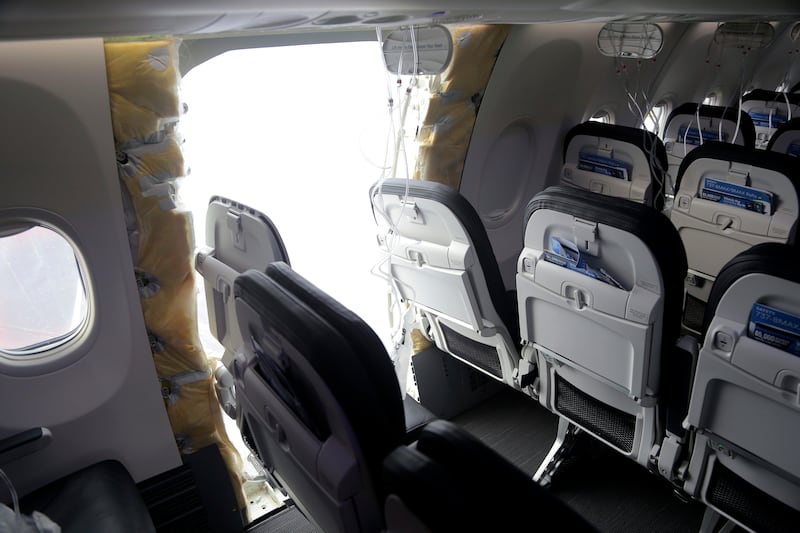Shares in Boeing and supplier Spirit AeroSystems both tumbled on Monday as investors weighed the financial fallout from Friday’s mid-flight accident on an Alaska Airlines aircraft.
US investigators announced on Sunday that they had located the door that blew out of the Boeing 737 Max during the flight. The incident prompted an emergency landing and the grounding of some aircraft.
The door plug – a “key component” for investigators – was located in the backyard of a Portland resident on Sunday night, according to Jennifer Homendy, chair of the National Transportation Safety Board, the independent US government agency responsible for investigating civil transport accidents.
The Alaska Airlines flight was carrying 171 passengers and six crew when a section of the fuselage was torn away. All of those on board landed back safely at Portland, Oregon.
The Federal Aviation Administration, the US airline regulator, ordered the temporary grounding on Saturday of some 737 Max 9s operated by US airlines or in US territory, while the NTSB has opened a probe into the incident.
Boeing shares fell 8 per cent to $229 (€209) in pre-market trading on Monday. Shares in Spirit AeroSystems were down 16 per cent. The company, a key Boeing supplier, installs the plugged door as part of the construction of the 737 Max fuselage for some aircraft. Its role has been under scrutiny over the past year amid manufacturing problems.
Homendy said pilots had reported pressurisation warnings on three flights in the month before the incident. Those incidents were described to the NTSB as “benign” and it was unclear whether the previous warning lights had any correlation to Friday’s incident, she said.
However, “it’s certainly a concern and one we want to dig into”, she added.
Alaska Airlines had placed a restriction on the plane preventing it from flying long overseas journeys, such as to Hawaii, so it could quickly return to an airport if needed. The carrier had also ordered additional maintenance on the light which had not been completed at the time of the incident, said Homendy.
Photos and videos shared on social media by passengers show a portion of a side wall of the plane and a window missing and oxygen masks deployed.
Homendy described the situation onboard after the door plug blew out as “chaos” and described extensive damage inside the plane including seats bent out of shape and tray tables torn away. “My impression when I saw that was it must have been a terrifying event to experience,” she said.
Boeing has called a company-wide safety meeting for Tuesday to discuss its response to the incident.
Chief executive David Calhoun, who will host the meeting from the Renton, Washington, factory where the Max is assembled, said the meeting would reinforce the company’s focus on safety.
“When serious accidents like this occur, it is critical for us ... to understand and address the causes of the event, and to ensure they don’t happen again,” he said in a memo to employees on Sunday.

The accident occurred at about 16,000 feet and just 10 minutes into the flight, the NTSB said. No one was in the two seats next to the deactivated exit cabin door that blew out, leaving a gaping hole in the fuselage of the plane.
While often used as an additional exit on more densely configured low-cost carriers, the door is permanently plugged on Alaska Airlines planes.
“[The] most astonishing thing to me is that the door came off,” said John Cox, a retired pilot and chief executive of Safety Operating Systems, an aviation safety consultancy. Other types of aircraft similarly use plug-in doors, he noted, adding: “I don’t know of any case where this has occurred previously.”
Given that the aircraft was just two months old, investigators would look “in great detail at the assembly records and quality assurance inspections of that part of the aeroplane”, said Cox.
Homendy said on Saturday that while the investigation was focused on the Alaska Airlines incident and not on Boeing’s Max fleet more broadly, “we’ll go where the investigation takes us”.
The accident is the latest blow to Boeing, which has struggled with manufacturing defects on the 737, and has continued to weather the fallout from a 20-month worldwide grounding imposed by regulators after a pair of deadly crashes five months apart in 2018-19.
The aerospace group said in a statement on Saturday that it supported the temporary grounding.

Housing in 2024: ‘several more years before we see the quantity of houses we need’
“Safety is our top priority,” Boeing said. “We agree with and fully support the FAA’s decision to require immediate inspections of 737-9 aeroplanes with the same configuration as the affected aeroplane.”
There are 215 Max 9 aircraft in service globally, according to data from aviation consultancy Cirium. The biggest operators are United Airlines and Alaska Airlines in the US, Turkish Airlines and Copa Airlines of Panama.
Copa said it had temporarily suspended flights of 21 Boeing 737 Max 9 jets. Turkish said it had withdrawn its small fleet of five Max 9 aircraft.
Alaska Airlines cancelled 21 per cent of its flights on Sunday, while United cancelled 8 per cent, according to flight data website FlightAware. Copa and Aeroméxico reported cancellations of 14 and 11 per cent, respectively.
The European Union Aviation Safety Agency said it had adopted the FAA’s emergency directive but that this was a “precautionary measure as we understand from both the FAA and Boeing that no European airlines in Easa member states currently operate an aircraft in the affected configuration”.
Copyright The Financial Times Limited 2024
.
(c) Copyright Thomson Reuters 2024

